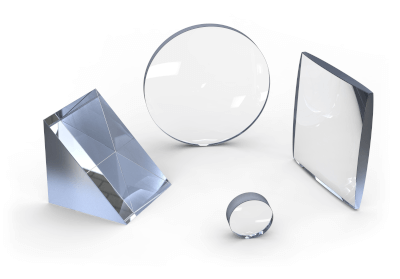What Is Optical Glass?

Optical glass is glass made of silica stone or silica sand, mainly composed of silicon (silicon), and contains very few impurities that could compromise its transparency.
Because it is homogeneous and has few air bubbles or scratches, it is used in optical devices that transmit light, such as lenses and prisms. BK7 is used mainly in the visible region, while fused quartz or synthetic quartz is used in the ultraviolet region.
There are various grades of synthetic quartz, and it is important to note that the transmittance, especially in the ultraviolet region, varies depending on the material and grade.
Uses of Optical Glass
Optical glass is often used for optical elements that transmit light, such as lenses, prisms, optical filters, and window plates for detectors. It is also used for light propagation in light guides and optical fibers. Optical glass is also used in exposure devices, which are important equipment in semiconductor manufacturing.
As the integration of semiconductor devices increases, the purity and precision of optical glass must be further improved. Radiation shielding window glass, which shields only against radiation, is also used in a variety of fields, as glass properties can be changed by additives.
Applications in research and experiments are as follows:
1. Basic Research
In basic research, optical glass can be used as a substrate, and samples can be coated or deposited on the glass for spectroscopic measurements. Graphene, a two-dimensional material that has attracted much attention in recent years, has also been transferred onto optical glass and is now available for sale. Graphene is usually fabricated on copper substrates. However, by transferring it onto glass substrates, it can be used in various spectroscopic studies due to its ability to observe transmitted light.
2. Optical Experiments Using Lasers
Optical glass may also be used in optical experiments using lasers. For example, optical glass is used as a reflector. In general, glass has a higher refractive index at the wavelength of blue light compared to red light, and of the light that passes through it, blue light travels faster than red light.
Therefore, optical glass can also be used to control the wavelength dispersion of pulsed light in pulsed lasers to increase (chirp) or decrease the pulse width when dealing with light that exists in a specific region on the time axis, as in pulsed lasers.
Principles of Optical Glass
Among types of optical glass, synthetic fused silica has no internal bubbles or scratches, is highly transparent, and can transmit light in the ultraviolet region. Synthetic quartz used to be the optical element for transmitting ultraviolet light in the past. However, recent technological advancements have enabled the development of products that achieve ultraviolet light transmission through resin.
In addition to transmittance at each wavelength and foreign matter, optical glass is important not only for its transmittance but also for its non-uniformity of refractive index. This is caused by the linear or layered formation of glass material with a refractive index that differs from the principal refractive index. For example, consider a lens, which is an optical component that bends and focuses light. The greater the difference in refractive index between the lens and air, the more light bends, and the closer the lens can focus light (shorter focal point), the smaller the optical system can be.
Cutting and polishing are the most common manufacturing methods. However, for fused silica glass, which has a low melting point, molding or press molding may be used for inexpensive mass production. Whether optical polishing is applied to one or both sides is selected at the time of order placement, and prices vary.
Other Information on Optical Glass
Refractive Index of Optical Glass
The refractive index of optical glass is larger in the ultraviolet region than in the infrared region and has a smooth dispersion. This dispersion varies depending on the glass material and is very important in optical experiments using the refractive index.
For example, the refractive index of synthetic quartz is approximately 1.48 at wavelengths around 340nm, 1.457 at 650nm, and 1.452 at 900nm. The refractive indices of BK7 are approximately 1.54 near 340nm, 1.514 near 650nm, and 1.509 near 900nm. The dispersion of the refractive index can be checked in advance, as each manufacturer provides it.
The wavelength dispersion of the pulsed light of a pulsed laser is affected by the above difference in refractive index. The group velocity dispersion of the pulses can be controlled by the material and the thickness of the glass. Therefore, the pulse shape can be designed based on the information of the difference in refractive indices of each wavelength.